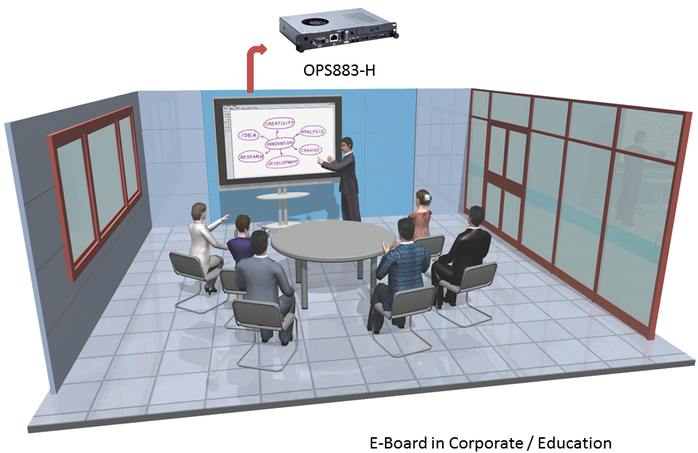 |
|
|
Digital Signage Makes Fast Work of Integration with OPS Fast Tracking: Q&A with Bill Lee Published on: August 14th, 2015 Global perspective on the digital signage market, the impact of Intel’s Open Pluggable Specification (OPS), the IoT’s role and more. Editor’s note: Axiomtek’s Bill Lee is North American product manager, responsible for the company’s digital signage and embedded panel PC product line. Lee spoke with EECatalog recently about topics including the impact the Internet of Things (IoT) has made on the digital signage market, the key role a vendor’s ability to offer services plays—Axiomtek offers a full gamut, from hardware customization to configuring for memory capacity to integrating customer software— and understanding what’s involved in calculating Total Cost of Ownership (TCO). Edited excerpts of the conversation follow. Embedded Intel Solutions: How did Intel®’s introduction of the Open Pluggable Specification (OPS) make a difference?
Intel has been a big influencer in the digital signage industry. They were in the right position at the time to set and promote a standard. There were some pluggable specifications from display companies like NEC and computer manufacturers like Axiomtek, but the specifications were not widely adapted. Customers wanted easy installation process without compatibility issues between all components especially the display and the pluggable digital signage player. Intel® standard has made it possible to ensure seamless integration and, through the simplified OPS architecture, allowing the customers to switch out/upgrade/maintain the computer player with ease. Embedded Intel Solutions: What’s the extent of Axiomtek’s involvement with OPS? Lee: We followed Intel’s OPS spec from the very beginning. The Intel team that developed the specification consulted with Axiomtek at our headquarters in Taiwan because we had the experience of having developed a pluggable specification. We worked closely with Intel on planning the specification itself and on following it to make our own OPS module. So beginning with 2nd generation Intel® Core™ processors, which were when the OPS spec was introduced, we have continued on to products based on the 4th generation Intel® Core™ microarchitecture (Figure 1).
Figure 1: Axiomtek's OPS883 comes equipped with a choice of 4th Generation Intel® Core™ processors (i7/i5/i3) or Intel® Celeron® processor. It supports dual display and 4K resolution. It also supports DDR3 SO-DIMM memory with up to 8GB and offers one PCI Express Mini Card slot for connectivity. Read more here. Embedded Intel Solutions: Why did you move to the Intel desktop platform? 4th Generation Intel® Core™ i7/i5/i3 & Intel® Celeron® processors. Lee: All other vendors of OPS systems base them on Intel’s mobile platform, which means lower power requirements. However, because Intel’s strategy is that mobile processors have to be soldered onto the motherboard starting from the 4th Generation Intel® Core™ processors, this makes it difficult for customers to configure the system according to their needs. Moving to the Intel desktop platform bypasses the soldered on CPU, allowing for flexibility in configuration. It enables customers to choose the CPU that will suit their requirements—4th Generation Intel® Core™ i3/ i5/i 7 processors or Intel Celeron® processors. This approach also makes it easier for customers to scale the deployment of their digital signage systems and to satisfy the requirements of the various operations where the signage is deployed. And because desktop processors generally cost less than mobile processors, this lowers the cost-performance ratio. Embedded Intel Solutions: Beyond just supplying hardware, Axiomtek also offers design engineering services. What challenges are these engineers encountering? Lee: One challenge is the compatibility issue between the OPS and the display. We come across cases, where, for example, the display does not show anything from the OPS player or the display cannot power up the OPS player. We ensure compatibility in two ways. One, we test and adjust our OPS player to work with the display the customer selected. Two, if we find incompatibility issues that cannot be adjusted on our end, we will work with the display vendor closely until the issue is resolved. On many occasions, our troubleshooting steps involve getting down to board level within the display unit to diagnose the problems and provide viable recommendations for corrections. As a part of our standard operating procedure, we do strict verification tests on our designs. For example, we check that all the signals from the ports are compliant with the standard. Another example of our verification tests involves the use of our OPS player in harsh operating environments. The OPS players could be used in an indoor environment in which the temperature rises to 100 degrees F., perhaps as a factor of clustering systems closely together. We do make sure that our players can endure that environment. We have a temperature testing chamber that allows us to check for reliability in an extended temperature operation. Embedded Intel Solutions: What trends and differences are you observing in the digital signage sector? Lee: An approach in which cost is the driving factor is prominent in the North American region, a trend that differs from attitudes in Europe and Asia. Other parts of the world have already gone through the phase of thinking they could get by with consumer type digital signage systems for commercial use and are now turning to more reliable systems.
Figure 2: Large screen displays are being used to replace traditional whiteboards and touch screens to allow students to interact with the content on the screen. In a corporate environment, digital whiteboards bridge the communication gap and allow for effective remote interactions between staff members and clients in meetings. Digital signage in the U.S. has started later than in other areas of the world, and there are customer requests that tend to favor budget over product quality and reliability, reflecting a belief that digital signage equipment costs should be similar to that of a television or a very low-cost computer—with less thought given to the reliability of the digital signage player operation and the product’s longevity. Deployments made with an eye toward low cost rather than quality may be okay in the short run, but after two years, the system will begin to need repair and maintenance more frequently. The cost of repair and operational downtime will most likely be more than the cost to purchase a higher quality OPS product to begin with. A more reliable ruggedized solution will ensure dependability from the very beginning. A focus just on initial cost is a mistake. It is better to consider all the elements of Total Cost of Ownership, including maintenance, downtime and the replacement costs of the systems that failed. For more information about our latest OPS digital signage players, fill out an inquiry form here. |
|
|
Copyright 2022 Axiomtek Co., Ltd. All Rights Reserved |
|
.jpg)
 Bill Lee, Axiomtek: Before OPS was introduced; most digital signage systems consisted of a single computer or player with a monitor or were comprised of a monitor that incorporated a computer that could not be removed easily. With the introduction of OPS, outside the traditional “one computer to one display with a functional cable between the two” paradigm, came easier installation, easier maintenance and faster time to market. Customers want the clean installation made possible by the OPS architecture and the ease of switching out the computer player.
Bill Lee, Axiomtek: Before OPS was introduced; most digital signage systems consisted of a single computer or player with a monitor or were comprised of a monitor that incorporated a computer that could not be removed easily. With the introduction of OPS, outside the traditional “one computer to one display with a functional cable between the two” paradigm, came easier installation, easier maintenance and faster time to market. Customers want the clean installation made possible by the OPS architecture and the ease of switching out the computer player..jpg)
